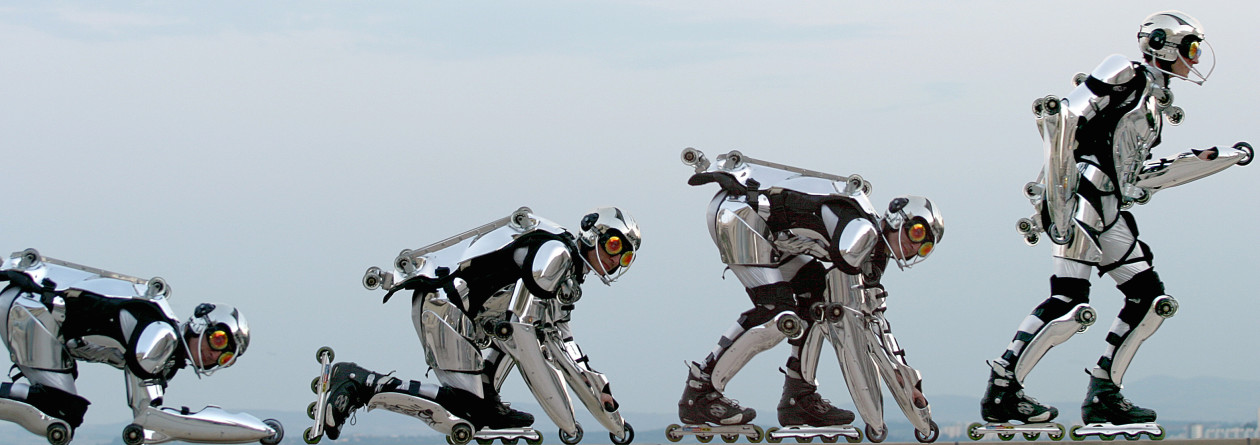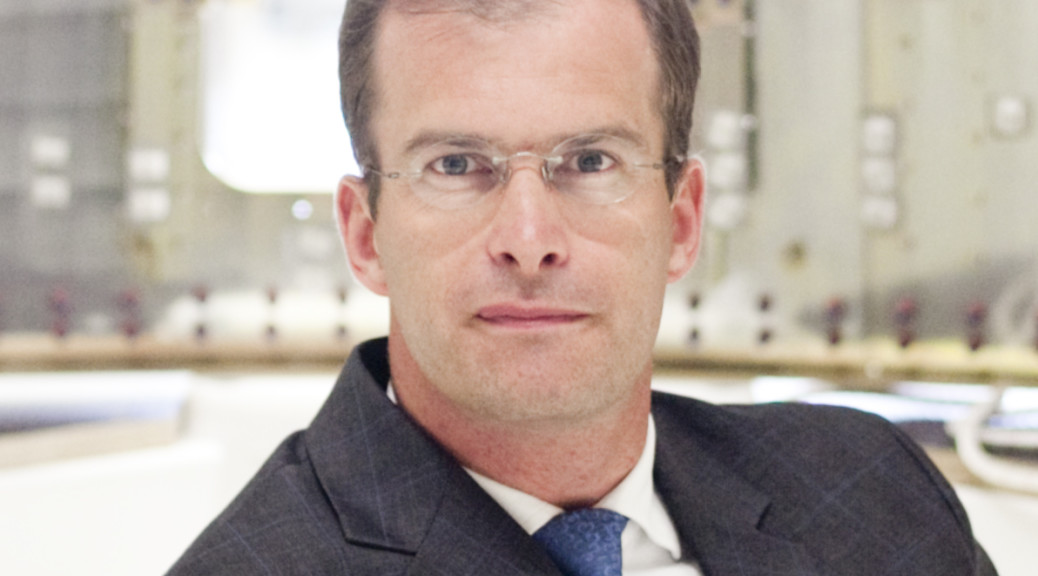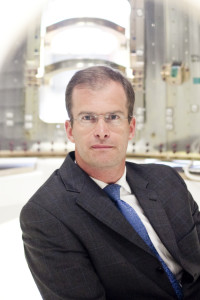[HET INTERVIEW]
tekst erwin van den brink
foto’s jordi huisman: www.jordihuisman.nl
Ir. Bart Reijnen koppelt Europees bewustzijn aan commercieel denken
‘Dat het luchtvaart moest zijn, stond voor mij vast’
Dutch Space directeur ir. Bart Reijnen heeft een feilloos gevoel voor de rol die Nederland hoort te spelen in de Europese lucht- en ruimtevaartbranche. Het heeft geen zin onze nationale ruimtevaart ‘geïsoleerd te koesteren als een kasplantje’, zegt hij. Wel is het belangrijk dat we speerpunten kiezen. ‘Iets waarvan de hele wereld zegt: dát doen ze in Nederland.’
Bart Reijnen, directeur van Dutch Space, is een echte Europeaan. Hij is jong (38), een slimme bèta en iemand met industriële genen. Dat is vrij bijzonder, want doorgaans zijn echte Europeanen niet mensen uit de industrie maar mensen uit het Haagse, politieke discours. Vaak zijn dat alfa- en gammamensen, geen bèta’s… Zij zijn ‘continentaal’ georiënteerd, terwijl de leidende figuren in het bedrijfsleven en de industrie meestal Angelsaksisch denken; atlantici met altijd een schuin oog gericht op de Verenigde Staten.
Deze verdeling heeft geleid tot een mentale kloof tussen overheid en industrie, die binnen Europa nergens zo diep is als in Nederland.
In de persoon van Bart Reijnen lijkt die kloof echter gedicht te worden. Als directeur van Dutch Space koppelt hij een sterk Europees bewustzijn aan commercieel denken en de behartiging van nationale belangen.
Dutch Space is een volle dochter van het Europese ruimtevaartbedrijf Astrium dat op zijn beurt weer onderdeel is van EADS, European Aerospace & Defense Systems, het grootste lucht- en ruimtevaartconcern ter wereld. Het in Leiden gevestigde bedrijf is na een aantal onzekere jaren in rustiger vaarwater terechtgekomen. In 2009 heeft Dutch Space voor honderd miljoen euro aan projecten verworven. Door de bank genomen is dat voor 90 % Nederlands belastinggeld, omdat het indirect afkomstig is van onze nationale deelname aan projecten van de Europese ruimtevaartorganisatie ESA. ESA ploegt het ontvangen geld grotendeels terug naar Nederlandse bedrijven, in de vorm van orders.
Reijnen: ‘De Nederlandse overheid heeft er jaren geleden voor gekozen als lid van de EU de Europese ruimtevaart te steunen en daar solidair in mee te doen. Dan heb je het recht dat met je eigen industrie te doen.’ De reden is dan niet nationaal prestige of politiek hobbyisme, legt hij uit, maar het besef dat ruimtevaart de bron is van veel innovatie die juist buiten de ruimtevaart praktische en commerciële toepassing vindt.
‘Daarom zie je dat landen als India, China en Brazilië allemaal inzetten op ruimtevaart. ’ In ruimtevaart is alles immers extreem. De krachten die werken op constructies zijn extreem. Die constructies moeten heel licht en tegelijk zeer sterk zijn. Systemen moeten uiterst betrouwbaar zijn, want eenmaal in de ruimte kun je er niet meer bij komen. Daarom is ontwerpen in de ruimtevaart, meer dan waar ook, ontwerpen op het scherp van de snede. Cutting edge technology, zoals dat in het Engels heet.
Reijnen: ‘De landen om ons heen hebben op een beperkt aantal thema’s een specifiek technologiebeleid. Als zij dat doen op het terrein van de ruimtevaart en wij doen dat in Nederland niet, dan verkeren we in het nadeel. Dan is er geen level playing field.’
Hoewel het altijd beter kan, is Reijnen blij met de 120 miljoen die er vanuit de ministeries van EZ en OC&W en de organisatie NWO jaarlijks specifiek beschikbaar is voor ruimtevaart. Waar hij ook verheugd over is: er is sinds 1 juli 2009 een centraal aanspreekpunt bij de overhead, de Netherlands Space Office (NSO). ‘Voorheen hadden we te maken met meerdere ministeries en instellingen. Het NSO helpt bij het voeren van een helder en eenduidig beleid. Dat is een goede zaak.’
De middelen die Nederland heeft voor ruimtevaart zijn echter beperkt. Reijnen: ‘Daarom heeft het ook geen zin om Nederlandse ruimtevaart geïsoleerd te koesteren als een kasplantje. Het is veel beter om het in te bedden in een groter, Europees, geheel. Dat is EADS’. Deze lucht- en ruimtevaartgigant ontstond door de fusie van drie nationale bedrijven, het Duitse DASA, het Franse Aerospatiale en het Spaanse CASA. Reijnen was erbij toen EADS werd opgericht. Hij was in 2000 de assistent van Rainer Hertrich, die samen met Philippe Camus de eerste tweekoppige directie vormde van EADS.
gigantische motivator
Dat hij erbij was toen EADS ontstond, dankt Reijnen aan een aantal atypische keuzes in zijn loopbaan. De Limburger was als jongen gek op vliegtuigen en wilde straaljagerpiloot worden, maar hij bleek daarvoor te lang. Verkeersvlieger leek hem niets: ‘zoiets als buschauffeur, maar dan elke dag op en neer vliegen.’
Reijnens vader is wiskundeleraar dus Bart had het kraken van problemen met de paplepel ingegoten gekregen. ‘Dan maar lucht- en ruimtevaart in Delft doen, dacht ik.’
‘Als ik niet het niveau had gehad voor een wetenschappelijke opleiding, dan was ik vliegtuigtechnicus geworden bij de luchtmacht, maar dat het iets met luchtvaart moest zijn, stond voor mij vast.’
Omdat iedereen in Delft stage liep bij Fokker of anders in de Verenigde Staten, koos Reijnen voor een alternatief. Het werd een stage bij Deutsche Aerospace, DASA.‘Die stage deed ik in een team van twee Nederlanders en twee Duitsers. Dat multinationale aspect sprak mij aan.’
Hij was 26 toen hij in 1998 klaar was en solliciteerde bij DASA op de functie van assistent-projectleider Airbus A 3XX, wat later de A-380 werd. ‘Dat was echt super! Mijn eerste grote job en ik was de rechterhand van Jürgen Thomas, echt een goeroe op het gebied van vliegtuigontwikkeling. Ik keek enorm tegen hem op. Hij was toen al ouder dan zestig jaar. Bij elk vliegtuigproject in Europa dat er maar enigszins toe had gedaan, was hij wel betrokken geweest.’
‘Overal waar je in Europa kwam bij vestigingen van Airbus zinderde het. Grote borden en plakkaten waarop dan stond: “Hier wordt straks de romp, vleugel, vul maar in… gebouwd van de A-380.” Het was een gigantische motivator. Dagelijks positief in het nieuws. Het is jammer dat er later problemen in de aanloop van de productie zijn geweest, die hebben gezorgd voor negatieve publiciteit. Maar dit vliegtuig gaat een heel groot succes worden, daarvan ben ik overtuigd.’
Na drie jaar liep de detachering van Reijnen vanuit DASA bij Airbus in Toulouse (Frankrijk) af. Juist op dat moment diende zich de mogelijkheid aan assistent te worden van Rainer Hertrich bij het nieuwe EADS, waarin Airbus zou opgaan. ‘Het was enorm fascinerend om met je neus bovenop die hele industrie te zitten. Alle informatie die Rainer Hertrich kreeg, zag ik ook. Hij moest op grond daarvan zijn beslissingen nemen, hij leidde er het bedrijf mee en ik deed er niets mee. Maar ik kon het soms niet laten om met de kennis die ik had een besluitvormingsproces voor mijzelf te doordenken. Hoe zou ik beslissen? Het was een heel intensieve werkrelatie waarvan ik veel heb geleerd. Het was ook opwindend, want EADS is het eerste puur Europese bedrijf. Het is geen conglomeraat of consortium meer met daarbinnen nationale belangen. Het loopt vooruit op de politieke eenwording van Europa. Er zijn geen nationale aandeelhouders meer in EADS, zoals destijds bij Airbus dat in Duitsland te weinig Duits was en in Frankrijk te weinig Frans. Er zijn nu in de hele wereld aandeelhouders van het Europese bedrijf EADS.’
Zo heeft EADS in het Verenigd Koninkrijk het gedeelte van het voormalige British Aerospace overgenomen dat van oudsher alle vleugels voor Airbus bouwt. Dat bedrijf is nu niet meer Brits, maar 100 % dochter van het Europese EADS, dat overigens om louter belastingtechnische redenen een Nederlandse N.V. is. De holding is gevestigd in hetzelfde gebouw in Leiden waar Dutch Space zit, de Astriumdochter van EADS. En dus nodigde Bart Reijnen de raad van bestuur van EADS onlangs uit om na de maandelijkse vergadering even een kijkje te nemen in de clean rooms.
Nu hij de organisatie bij Dutch Space zo ver op orde heeft, is het zaak te gaan nadenken over wat hij noemt ‘de stip op de horizon’. Dutch Space heeft bijvoorbeeld de prestigieuze robotarm voor het International Space Station (ERA) ontwikkeld. Maar hiervan wordt er slechts één gebouwd. Reijnen wil naar meer serieproductie waarbij het bedrijf profijt gaat hebben van de leercurve. Dat biedt continuïteit. Nederlandse zonnepanelen hebben al een goede reputatie. Ongeveer tweederde van de ESA-missies vliegt nu met Nederlandse zonnepanelen. Motorophangingen en verbindingssecties tussen rakettrappen zijn (in samenwerking met Stork en TNO) andere sterke punten. De ontwikkeling van zeer geavanceerde instrumenten, samen met SRON en het KNMI, is iets waarin Dutch Space ook internationaal een goede reputatie heeft. Zowel op het gebied van ruimteonderzoek als in aardobservaties ten behoeve van bijvoorbeeld klimaatonderzoek kan Nederland bogen op een reeks successen.
Reijnen: ‘Maar welke thema’s wil Nederland nu eigenlijk echt voor zich gaan claimen? Iets waarvan de hele wereld zegt: dát doen ze in Nederland. Binnen NSO is de ruimtevaartsector met de overheid in overleg over deze hamvraag.’
Dat is misschien wel het wezen van de Europese industrieel Reijnen: nationale belangen bundelen en kennis richten op een beperkt aantal onderwerpen om juist een aantrekkelijke en sterke partij te zijn voor Europese samenwerking. Reijnen: ‘De Europese eenwording betekent niet dat we als Nederland achterover kunnen gaan leunen in de veronderstelling dat als wij het niet doen, mooie nieuwe technologie wel ergens anders in Europa wordt ontwikkeld.’
Want dan grijp je op een gegeven moment naast die technologie als je hem nodig hebt. ‘Dus je moet Europees denken en daarbij oog houden voor nationale belangen’, stelt Reijnen. Kort en goed: omdat andere lidstaten aan ruimtevaart doen, is Nederland wel gedwongen mee te doen. ‘Als wij Nederland of Europa – de Europese Commissie is een steeds belangrijker opdrachtgever, denk aan Galileo –als opdrachtgever hebben in het voorcommerciële traject, dan kunnen wij vanuit die ervaring technologie bouwen die vervolgens ook wereldwijd commercieel te verkopen is.’
[kader kengegevens]
KENGEGEVENS
NAAM
Bart Reijnen
LEEFTIJD
38
TITEL
Ir.
OPLEIDING
Lucht- en Ruimtevaarttechniek, TU-Delft
FUNCTIES
Directeur Dutch Space (vanaf 2006)
Hoofd Bestuursbureau EADS (2004-2006)
Assistent van Rainer Hertrich, ceo EADS (2000-2004)
Hoofd A380-projectplanning, Airbus Toulouse (1998-2000)
Assistent van de hoofdconstructeur A380 (1997-1998)
[QUOTES]
‘Ik was de rechterhand van Jürgen Thomas, echt een goeroe op het gebied van vliegtuigontwikkeling.’
‘Welke thema’s wil Nederland nu echt voor zich gaan claimen?’
‘Je moet Europees denken en daarbij oog houden voor nationale belangen.’
[BEELD
zie reijnen1 en reijnen2]


